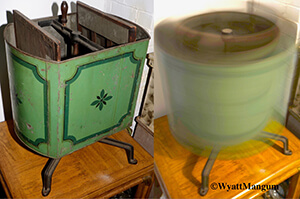
The January 1870 American Bee Journal contained an article by J.L. Peabody, who presented a description and a picture of a honey extractor invented by his brother H.O. Peabody (see Figure 1). During this early time of developing a suitable honey extractor, numerous creative designs arose. Some of these designs would be surprising to the modern beekeeper –– the Peabody extractor among them.
To appreciate the novelty of a Peabody extractor, here is a brief description of it. The metal can of the extractor resembled a wash tub used to heat water for washing clothes. (A straight-sided tub with curved ends was typical of the late 1800s.) Where the straight sides began curving inward, two wire screens were inserted across the can. The screen wire was made from a thick wire gauge and was woven instead of being soldered, an automated technology still off in the future. For additional strength, the screens were mounted in wooden frames. Two frames of uncapped honey were loaded in the extractor so the combs resided against the woven wire for support during rotation. With its upper opening accepting a wide width, the extractor could accommodate any size frame, an important advantage in a time before standard frame sizes (see Figure 2).
The frames rotated by turning the prominent offset handle attached to the main iron beam across the middle of the can. Here we meet the most sublime uniqueness of a Peabody extractor. Turning the handle –– rotates the can and the frames (see Figure 3). And that’s not all.
While spinning, the liquid honey flung out of the cells hit the inner curved walls of the extractor –– and stayed there. Yes, the honey remained “pressed” against the can’s vertical walls until the rotation slowed (decreasing the centrifugal force). At that time, the honey ran down the ends of the can and drained down the inclined bottom toward the center. A pan under the middle of the extractor caught the honey flowing from its bottom hole under the center shaft.
The strange gravity-defying honey even stymied Dr. C.C. Miller, the famous beekeeper who wrote numerous articles and books on beekeeping, as well as a column in this magazine. He, his wife, and her sister managed some 300 colonies (in eight-frame hives), producing section comb honey (which was labor intensive and required a high level of colony-management skill).
Selling honey in the comb (put there by the bees) was the emblematic mark of honey purity, in a time rampant with adulterated consumer products. Liquid honey was frequently adulterated with cheap sugars to increase its volume. (Beeswax was adulterated too. The cheaper waxes could not withstand the brood nest warmth. Full sheets of foundation, made from adulterated beeswax, typically collapsed under the weight and warmth of wax-producing bees clinging to it.)
Times began changing though –– to eliminate the practice of adulteration. Liquid honey would become more acceptable to consumers. Veteran comb-honey beekeepers began learning how to use honey extractors, including Dr. Miller. The first run with his new Peabody extractor in 1870 has lost none of its novelty even after some 150 years.
From his book, “Forty Years Among the Bees,” Dr. Miller recounts the events: “… [T]he supreme moment of interest coming when after having given perhaps 200 revolutions to the extractor I looked beneath to see how much honey had run into the pan below. Very vividly I remember my keen chagrin and disappointment when I found that not a drop of honey had fallen.” Then Dr. Miller immediately realized the same force spinning the honey out of the cells would hold it against the turning can. “When the can stopped revolving, a fair stream of honey ran down into the pan, and I resumed my normal manner of breathing.” So with the Peabody extractor, the honey does not drain from the frames until after the “extracting” stops.
After spinning honey from the outer sides of the two combs, the frames had to be reversed manually. That is beekeeping slang. It means each frame had to be lifted from the can, rotated to put its inner comb side, still loaded with uncapped honey, to the outer side. After both the frames were returned to the extractor, they were spun again. In this regard, the Peabody extractor is reminiscent of a modern two-frame nonreversible extractor. For my 125 frame-hive operation that I built up and managed for honey production during the last of my high school days, my first extractor was a used four-frame nonreversible extractor. The frames were positioned like the sides of a square, turning (tangentially) around the center vertical axis. With only a hand crank, I extracted by night, all night, in a small backyard tool shed, the darkness holding back the robber bees determined to reclaim their treasure. It took a lot of cranking to extract a ton of honey. Most of the work night remained quiet, because back then radio stations in Richmond, Virginia quit broadcasting at 2:00 a.m. About a half hour before dawn, a low impatient hum began filling the still air around the shed. That was the robber-bee version of pounding on the door.
According to Pellet, the Peabody honey extractor, offered on its January 1870 date, was the first commercially available honey extractor in the United States.1 A small, rare scrap of that commerce survives as a brief letter signed by J.L. Peabody from 1872. Figure 4 shows the envelope graced with a Peabody extractor. Inside is a brief letter signed by …


